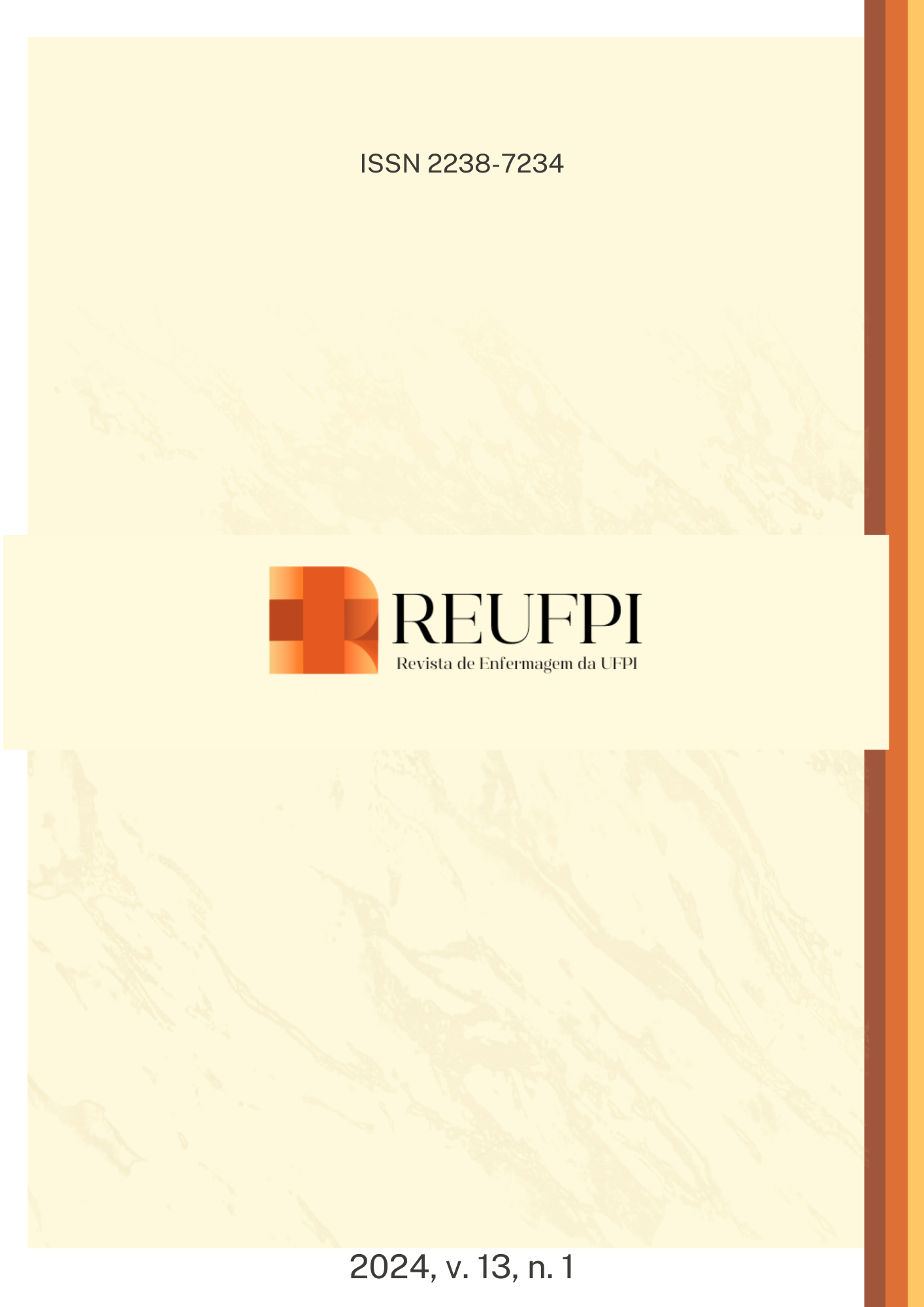Nursing care for maintenance and prevention of enteral probe loss
DOI:
https://doi.org/10.26694/reufpi.v13i1.4360Keywords:
Nursing care, enteral nutrition, nutritional support, Nutrition TherapyAbstract
Objective: To understand the perception and practice of nursing professionals about care related to the maintenance and prevention of enteral probe loss in hospitalization units. Methods: Quanti-qualitative and descriptive study carried out in a large general hospital in Belo Horizonte, Minas Gerais, Brazil. It was attended by 40 professionals, 19 nurses and 21 nursing technicians, interviewed in September and October 2018. Secondary data were collected from the medical records of 114 patients who were using an enteral probe from 01/01/2017 to 01 /01/2018. Results: It was observed that the majority (68.4%) of patients undergoing enteral nutritional therapy were over 60 years of age. Nutritional causes were the main indication for the use of probes, occurring in 51.7% of patients. Most (90.0%) of professionals recognize that washing the probe is the main care in terms of preventing loss of this device and recognize that the biggest complication of its use is bronchoaspiration. Conclusion: It was found that nursing professionals have knowledge about care related to maintenance and prevention of probe loss, but the perception of these professionals is different from the information introduced in the medical records, which may highlight a disarticulation between knowledge and care practice.
References
Bolognese MA, Souza PM, Néia VJC, Santos OO, Visentainer JV. Home nutrition therapy: a review. Research, Society and Development. 2022; 11(3): e34011326130. Doi: https://doi.org/10.33448/rsd-v11i3.26130
Ministério da Saúde (BR). Relatório para sociedade - suplementação nutricional oral para pacientes clínicos ou cirúrgicos desnutridos ou em risco de desnutrição- Ministério da Saúde, 2021. 9p.: il.: Dispnível em: http://conitec.gov.br/ Acesso em 21 setembro 2022.
Sauer AC, Goates S, Malone A, Mogensen KM, Gewirtz G, Sulz I et al. Prevalence of Malnutrition Risk and the Impact of Nutrition Risk on Hospital Outcomes: Results From nutritionDay in the U.S. JPEN J Parenter Enteral Nutr. 2019 Sep;43(7):918-26. Doi: https://doi.org/10.1002/jpen.1499
Silveira GC, Gomes Romeiro F. Difficulties and risks during the introduction and positioning of the Nasoenteric Probe. Nursing (São Paulo). 2020; 23(266): 4360–73. Doi: https://doi.org/10.36489/nursing.2020v23i266p4360-4373
Couto RC, et al. II Anuário da segurança assistencial hospitalar no Brasil: propondo as prioridades nacionais. Instituto de estudos de saúde suplementar. 2018. Disponível em: https://www.iess.org.br/cms/rep/Anuario2018.pdf. Acesso em 21 setembro 2022.
Barbosa LMR, Silva WAD, Souza Neto OM, Ribeiro LCS. Nursing care gastrointestinal intubation in adult patients. Rev enferm UFPE on line. 2021;15: e246556. Doi: https://doi.org/10.5205/1981-8963.2021.246556
Akçay K, Suluhan D, Kesik G, Uzunoğlu K, Kartal E, Şahna A. Nursing Practices in Enteral Nutrition. Clin Sci Nutri. 2020. Doi: https://doi.org/10.5152/ClinSciNutr.2020.984
Assunção ES, Reis FVF, Santos OV dos. Quality indicators in enteral nutrition therapy in patients at a university hospital in Pará J. Health NPEPS. 2019; 4(2):58-69. Doi: http://dx.doi.org/10.30681/252610103831
Souza KF; Costa MF; Santos RS. Are quality indicators of enteral nutritional therapy a useful tool for monitoring patients with advanced cancer in palliative care? BRASPEN J 2020; 35 (4): 402. Doi: http://dx.doi.org/10.37111/braspenj.2020354012
Waitzberg DL. Indicadores de qualidade em terapia nutricional: 10 anos de IQTN no Brasil: resultados, desafios e propostas. International Life Sciences Institute do Brasil (ILSI Brasil). 2018: 264p. Disponível em: https://ilsibrasil.org/wp-content/uploads/sites/9/2018/06/Fasci%CC%81culo-10-anos-de-IQTN-no-Brasil2-Final.pdf Acesso em: 21 setembro 2022.
Bortolotto B, Beccaria LM, Oliveira KA, Faria JIL, Barbosa TP. Accidental loss of nasogastroenteral probe for nutritional support in a hospital institution. CuidArte, Enferm. 2020; 14(1): 18-23. Dispnível em: http://www.webfipa.net/facfipa/ner/sumarios/cuidarte/2020v1/p.18-23.pdf. Date accessed: 2022 sep 25.
Davies N, Barrado-Martín Y, Vickerstaff V, Rait G, Fukui A, Candy B, Smith CH, Manthorpe C, Moore KJ, Sampson EL. Enteral tube feeding for people with severe dementia. Cochrane Database Syst Rev. 2021; 13(8): CD013503. Doi: https://doi.org/10.1002/14651858.CD013503.pub2 .
Colaço AD, Nascimento ERP. Bundle de intervenções de enfermagem em nutrição enteral na terapia intensiva: uma construção coletiva. Rev. Esc. Enferm. USP. 2014; 48: 844-50. Doi: https://doi.org/10.1590/S0080-623420140000500010
Boeykens KRN. Nutritional Support in the Intensive Care Unit: Implications for Nursing Care From Evidence-Based Guidelines and Supporting Literature. Dimens Crit Care Nurs. 2021; 40(1):14-20. Doi: https://doi.org/10.1097/DCC.0000000000000448
Amaratunga H, Bostock K, Cunich M, Steffens, Carey S. Systematic review of service improvements for home enteral tube feeding in adults. Nutr Clin Pract. 2023; 38(2), 329-39. Doi: https://doi.org/10.1002/ncp.10900
STROBE Statement—Checklist of items that should be included in reports of cross-sectional studies. Dispnível em: https://www.strobe-statement.org/checklists/ Date accessed: 2022 sep 20.
Weyne GRS. Determinação do tamanho da amostra em pesquisas experimentais na área da saúde. Arq Med. ABC. 2004; 29(2):87-90. Disponível em: https://www.portalnepas.org.br/amabc/article/view/301 Acesso em: 23 set 2022.
Oliveira DC. Theme/category-based content analysis: a proposal for systematization. Rev. enferm. UERJ, Rio de Janeiro, 2008 out/dez; 16(4):569-76. Dispnível em: http://files.bvs.br/upload/S/0104-3552/2008/v16n4/a569-576.pdf Date accessed: 2022 sep 20.
Ministério da Saúde (BR). Conselho Nacional de Saúde. Resolução nº 466, de 12 de dezembro de 2012. Diário Oficial da República Federativa do Brasil, Brasília, DF.
Rhiry-Cherques RH. Saturation in qualitative research: empirical sizing estimation. Af-Rev PMKT. 2009; 4(08):20-7. Dispnível em: http://www.revistapmkt.com.br/Portals/9/Edicoes/Revista_PMKT_003_02.pdf Date accessed: 2022 oct 15.
Oliveira RAM., Barão YF, Soares MD, Cônsolo FZ. Elderly people using nutricional terapy hospitalized for rehabilitation: profile, evaluation of caloric and protein supply and weaning of enteral diets. Multitemas. 2021; 26(63), 121–34. Doi: http://dx.doi.org/10.20435/multi.v26i63.2996
Queiroz MRG, Moura CX de, Marinho J da S, Maggioni L. Medical criteria to indicate and remove alternative feeding routes in hospitalized older adults. Rev CEFAC [Internet]. 2020;22(6):e2120. Dispnível em: https://doi.org/10.1590/1982-0216/20202262120
Sassi FC, Medeiros GC, Zambon LS, Zilberstein B, Andrade CRF. Evaluation and classification of post-extubation dysphagia in critically ill patients. Revista do Colégio Brasileiro de Cirurgiões. 2018; 45 (3), e1687. Doi: https://doi.org/10.1590/0100-6991e-20181687
Graciano RDM, Ferretti REDL. Enteral nutrition in the elderly in Intensive Care Unit: prevalence and associated factors. Geriatrics, Gerontology and Aging, 2008; 2(4), 151-5. Disponível em: http://ggaging.com/how-to-cite/322/pt-BR Date accessed: 2022 sep 22.
Anziliero F, Silva BA, Dal Soler BE, Corrêa APA, Beghetto MG. Adverse events involving enteral tubes: an integrative review. Rev baiana enferm. 2020; 33: e33850. Doi: https://doi.org/10.18471/rbe.v33.33850
Chauhan D, Varma S, Dani M, Fertleman MB, Koizia LJ. Nasogastric Tube Feeding in Older Patients: A Review of Current Practice and Challenges Faced. Current Gerontology and Geriatrics Research. 2021. Doi: https://doi.org/10.1155/2021/6650675.
Pereira SRM, Coelho MJ, Mesquita AMF, Teixeira AO, Graciano SA. Causes for the unplanned removal of the feeding tube in intensive care. Acta Paul Enferm. 2013; 26(4):338-44. Doi: https://doi.org/10.1590/S0103-21002013000400007
Wen X, Cai C, Wang S. The influence of clinical nurses’ risk perception of adverse events and shift quality on patient safety. Chin J Pract Nurs. 2017; 33(22):1735–9 Disponível em: http://d.wanfangdata.com.cn/periodical/syhlzz201722016
Bandura A. Social cognitive theory of self-regulation. Organ Behav Hum Decis Process. 1991;50(2):248–87. Doi: https://doi.org/10.1016/0749-5978(91)90022-l
Feng P, Yang HL, Xu L, Ojo O, Lu XY, Zhang HY, Wang XH. Development and psychometric testing of a questionnaire to assess Nurse's perception of risks during enteral nutrition. BMC Nurs. 2021 Jan 5;20(1):6. Doi: https://doi.org/10.1186/s12912-020-00520-z
Chu J, Wang X, Liang L, Zhao Y, Han M, Wang W, Jiang C. Construction and Application of Enteral Nutrition Nursing Management System under Medical Alliance Mode. Iran J Public Health. 2023 Mar;52(3):584-92. Doi: https://doi.org/10.18502/ijph.v52i3.12141
Matsuba CST, Serpa LF, Pereira SRM, Barbosa JAG, Corrêa APA, Antunes MS, et.al. Diretriz BRASPEN de enfermagem em terapia nutricional oral, enteral e parenteral. BRASPEN J. 2021;36(3 Supl 3):2-62. Doi: http://doi.org/10.37111/braspenj.diretrizENF2021
Corrêa APA, Nora CRD, Sousa GP de, Santos VJ dos, Viegas GL, Agea JLD, et al. Risks of enteral nutritional therapy: a clinical simulation. Rev Gaúcha Enferm [Internet]. 2020;41(spe):e20190159. https://doi.org/10.1590/1983-1447.2020.20190159
Silva LCS.; Prado MA; Fernandes SR.; Moraes Filho AV; Souza MC; Costa TAM et al. Nonconformities in medical records: opinion of health workers. Research, Society and Development. 2021; 10 (12): e294101220587. Doi: http://dx.doi.org/10.33448/rsd-v10i12.20587.
Downloads
Published
How to Cite
Issue
Section
License
Copyright (c) 2024 Rev Enferm UFPI

This work is licensed under a Creative Commons Attribution 4.0 International License.
Autores mantém os direitos autorais e concedem à REUFPI o direito de primeira publicação, com o trabalho licenciado sob a Licença Creative Commons Attibution BY 4.0 que permite o compartilhamento do trabalho com reconhecimento da autoria e publicação inicial nesta revista.






